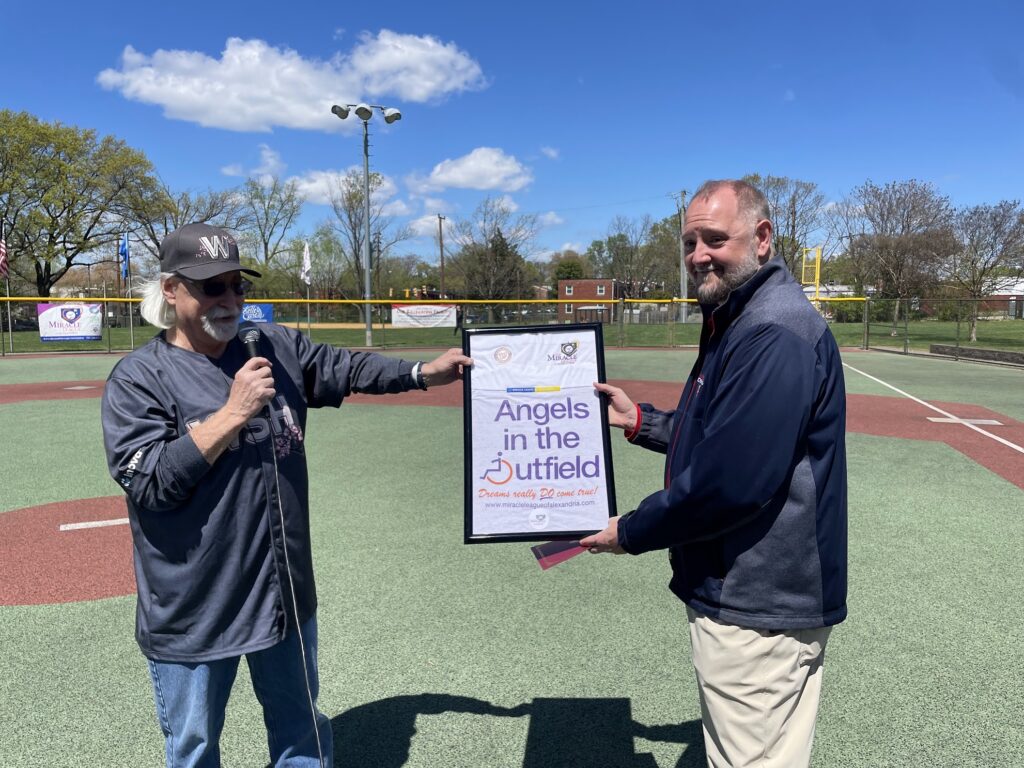Out of the Park Contributions Jumpstart Miracle League Alexandria’s Season
ALEXANDRIA, VA-The Miracle League of Alexandria (MLA) has started in full swing this year, with guest appearances from several local organizations bolstering its benches. The Miracle League, which has served Alexandria’s special needs community for over ten years, has once again opened its season, and its arms, with a warm embrace of the community and all those in it.
This year’s opening day was supported by the pros, as the Washington Nationals joined the MLA during the first game of the season. Through their Team Up program, the Nats generously donated game-ready jerseys and hats to every player in the league, making even the smallest members feel like they were in the bigs.

Ted Towne, CFO of the Nationals, personally oversaw the delivery of the nearly 100 uniforms with a wide smile and a matching cap of his own. The Team Up program is a DMV-wide event partnering with close to 1400 teams, helping defray costs for players and increasing accessibility to the sport. Towne said the mission of the program is simple. “We just want everyone playing baseball, and if they’re wearing a curly W, then even better.” And play they did. Players of all ages and abilities batted, tossed – and most importantly – smiled their way through an engaging and thrilling ballgame.
The MLA holds a special place in Towne’s heart. a special place in his heart. He said he completely understands the importance of making sports possible for those of all abilities – his own sister participated in the Special Olympics. The difference a sport can make in anyone’s life manifests in confidence, social skills, and naturally, happiness.

New gear wasn’t the only surprise. The Nats gave out tickets to the entire Miracle League for a family day at Nats Park. But contributions did not end there. A few weeks later, StarKist, the food company based in Virginia best known for its tuna fish, joined forces with Miracle League, presenting them with a check for $10,000.
Michelle Faist, Head of Corporate Affairs for StarKist, said the company is proud to support “an organization that champions inclusivity for adults and children with special needs with the power of baseball.”
Laura Fries, VP of the MLA’s board, said the money will be put to good use to build communication boards in the dugouts and front of the field. As she told The Zebra, “We have a lot of non-verbal players, and this would allow them to communicate with our volunteer Angels in the Outfield [helpers]. It’s a bridge to help everyone work together.”

Charlie, StarKist’s larger-than-life tuna mascot made an appearance during the game, sporting his iconic red cap. Tuna’s never stop swimming, and the Miracle League is no different. Despite the hot summer sun, the players and fans are undeterred. Their smiles never fade, and the bleachers are always full.

Such contributions go beyond their financial value. They create an environment where confidence and social skills can be built. They show the power of the community. Twenty-five years ago, this space did not exist. Today, it serves nearly half a million children and parents nationwide. The impact is real and human.
Deb Riley, a parent and Miracle League Board Member talked about the impact the program has had on her son, Tucker, who has cognitive, visual, and physical disabilities. “We are so lucky to have this very special sports program as it is the only one available in Alexandria that Tucker is able to participate in.” The league has given him an opportunity for growth and community that may not have otherwise been possible.
Deb Riley, a parent and Miracle League Board Member talked about the impact the program has had on her son, Tucker, who has cognitive, visual, and physical disabilities. “We are so lucky to have this very special sports program as it is the only one available in Alexandria that Tucker is able to participate in.” The league has given him an opportunity for growth and community that may not have otherwise been possible.
You would be hard pressed to find an organization in Alexandria that has more cross-collaboration than the MLA, including private, government, non-profit and educational organizations, who together have made something truly special. Even groups like the Psi Nu Chapter of the Omega Psi Phi Fraternity take on the essential task of grilling burgers and hot dogs every game. Anyone interested is welcome to join as a player, a volunteer, or as an enthusiastic fan.

ICYMI: Colonial Swim League Records Fall at Old Town Pool




